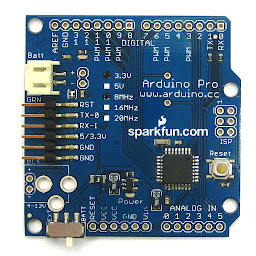What is
Arduino???
Arduino is
an open-source electronics platform based on easy-to-use hardware and software.
Arduino boards are able to read inputs, like light sensors, activating a motor,
turning on an LED, etc. Note! outside the USA they have changed the name to
Genuino.
A lot of
different Arduino boards exists, but Arduino UNO is the most popular and used
Arduino board.
Arduino
board designs use a variety of microprocessors and controllers. The boards are
equipped with sets of digital and analog input/output (I/O) pins that may be
interfaced to various expansion boards ('shields') or breadboards (For
prototyping) and other circuits. The boards feature serial communications
interfaces, including Universal Serial Bus (USB) on some models, which are also
used for loading programs from personal computers. The microcontrollers can be
programmed using C and C++ programming languages. In addition to using
traditional compiler tool chains, the Arduino project provides an integrated
development environment (IDE) based on the processing language project.
Some of
the important boards are:
Some Arduino-branded boards have been designed by the American companies SparkFun Electronics and Adafruit Industries.
 |
| Arduino RS-232 |

| Arduino Uno R2 |
 |
| Arduino Diecimila |
 |
| Arduino Duemilanove (rev 2009b) |
 |
| Arduino Pro |
 |
| Arduino Mega |
 |
| Arduino pro micro (AtMega32U4) |
 |
| Arduino Nano |
 |
| Arduino LilyPad 00(rev 2007) |
 |
| Arduino Esplora |
 |
| Arduino Ethernet (AVR+W5100) |
 |
| Arduino Yún (AVR+AR9331) |
Arduino Philosophy
- Free to modify and inspect.
- Making designs rather than talking about it.
- Open source hardware and software.
- Forums with lots of help.
Arduino
Environment
Arduino can
mean 3 things
- Physical piece of hardware.
- Programming environment.
- Community and philosophy.
Installing
the Arduino IDE
To make it as easy as possible to get started with the Arduino, the Arduino developers have created a simple but useful integrated development environment (IDE). It runs on many different operating systems. Before you can create your first projects, you have to install it.
Click here to download the Arduino IDE 👈
Sketch
A sketch is
a program written with the Arduino IDE.[59] Sketches are saved on the
development computer as text files with the file extension. ino. Arduino
Software (IDE) pre-1.0 saved sketches with the extension. pde.
A minimal
Arduino C/C++ program consists of only two functions:
setup ():
This function is called once when a sketch starts after power-up or reset. It
is used to initialize variables, input and output pin modes, and other
libraries needed in the sketch. It is analogous to the function main ()
loop ():
After setup () function exits (ends), the loop() function is executed
repeatedly in the main program. It controls the board until the board is
powered off or is reset. It is analogous to the function while (1)
Baud Rate:
The baud
rate is the rate at which information is transferred in a communication
channel. Baud rate is commonly used when discussing electronics that use serial
communication. In the serial port context, "9600 baud" means that the
serial port is capable of transferring a maximum of 9600 bits per second.
The signal
includes:
- Protocol overhead (e.g. start bits, stop bits, and parity bits) and
- Actual application specific data
In Arduino, you can use 300, 600, 1200, 2400, 4800, 9600, 14400, 19200, 28800, 38400,
57600, or 115200. However, 9600 is the standard baud rate usually used. Looking
at the last number you may think 115200 must be the highest baud rate, NO NOT!
The
ATmega328P uses a hardware divisor from it's clock-rate to generate the
base-clock for the serial interface. If there is no integer ratio from the main
clock to the bit-time of the desired baud rate, the MCU will not be able to
exactly produce the desired rate. This can lead to potential issues, as some
devices are much more sensitive to baud-rate mismatch than others.
FTDI-based
interfaces are quite tolerant of baud-rate mismatch, up to several percent error.
General serial interfaces are tolerant of ~5% baud-rate error. However, since
each end can be off, a more common spec is +-2.5%. This way, if one end is 2.5%
fast, and the other is 2.5% slow, your overall error is still only 5%.
The UNO uses
an ATmega328P as the primary MCU, and a ATmega16U2 as the USB-serial interface.
We're also fortunate here in that both these MCUs use similar hardware USARTs, and 16 MHz clocks. Since both MCUs have the same hardware and
clock-rate, they'll both have the same baud-rate error in the same direction,
so we can functionally ignore the baud error issue.
So, it
appears (according to data sheet) the hardware can run at 2,000,000 baud
without problems. You can test this by writing a code.
IMP: Here I have
used Arduino UNO as the example as it is widely used.
Languages
supported by Arduino:
The Arduino
IDE mainly supports C and C++, using special rules of code structuring. The Arduino IDE supplies a software
library from the wiring project, which provides many common input and output
procedures. Other than this Arduino IDE supports other languages also.
Some of the important
languages are given below
- C
- C++
- Java
- Python
- Sql
- MQttl.Etc.
- DAQduino
- Cortina
- Cypress PSoC 4 Pioneer Kit (CY8CKIT-042)
- Ardweeny
- SAM15x15
- Digispark. Etc.
- Arduboy, a handheld game console based on Arduino.
- XOD, a visual programming language for Arduino.
- Data loggers for scientific research. Etc.







3 Comments